Severe Storm Warnings for Four-Story Homeowners
Towards a Processing Model of Bracketing Paradoxes
University of Stuttgart
2024-06-11
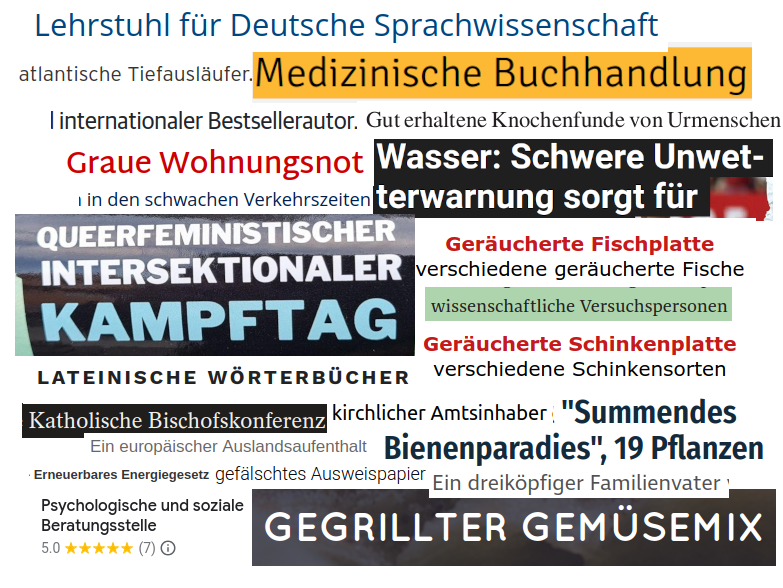
Why are some phrases ambiguous or preferentially interpreted as a bracketing paradox?
steiniger Fahrradweg stony bike.path
→ only a canonical reading
königliche Hochzeitsfeier royal wedding.celebration
→ both canonical and bracketing paradox readings
saurer Kirschbaum sour cherry.tree
→ only a bracketing paradox reading
Why are some bracketing paradoxes odd and others unremarkable?
schwere Unwetterwarnung severe storm.warning
→ warning for severe weather vs. severe warning for storms
? rustikale Wurstplatte rustic sausage.plate
→ a plate of rustic sausage vs. rustic plate with sausage(s)
?? dreiköpfger Familienvater three-headed family.father
→ the father of a family of 3 vs. Cerberus
?? vierstöckiger Hausbesitzer four-story home.owner
→ the owner of a 4-story home vs. gigantic owner of a home
??? fette Hennengasse fat hen.alley
→ the alley of the fat hen vs. the fat alley of the hen(s)
How do we model these phrases?
Do they violate the principle of compositionality? Is this an illusion? A garden-path effect? A metaphor? What are their components? What makes them possible and passable?
How are they processed?
There is barely any psycholinguistic research on this phenomenon!
Experiment 1
Does semantic compatibility between the adjective and the individual nouns affect the acceptability of the entire phrase?
psychologische
psychological
Beratungs-
counseling
stelle
center
AN1N2 Psychologische Beratungsstelle
psychological counseling.center
AN1 Psychologische Beratung
psychological counseling
AN2 Psychologische Stelle
psychological center
204 items (from literature and newspapers) in three conditions in 3 Latin square design lists
🚫 AN1N2 constructions where the adjective didn’t match either noun → unlikely to be used.
Predictions
Strict grammaticality and compositionality: the ratings for the AN2 should be predicative of the AN1N2 rating.
→ N2 is the head of the compound
Adjective 🩷 N2 → canonical
good ratings, straightforward and compositional
Adjective 🩷 N1 → (possibly) bracketing paradox
❔ ratings: bracketing paradoxes are a spectrum from unassuming to bizarre
N1 🩷 Adjective 🩷 N2 → ambiguous, maybe some bracketing paradox potential
Predictions
The adjective’s morphosyntactic features necessarily match those of N2
The adjective’s morphosyntactic features also match N1 → bracketing paradox potential
| königlichefem/pl | Hochzeitsfem | feierfem | ✔️ |
| schwerefem/pl | Unwetterneut/pl | warnungfem | ✔️ |
| saurermasc | Kirschfem | baummasc | ❌ |
Analysis
The ratings across scales were highly correlated (r ≥ 0.95)
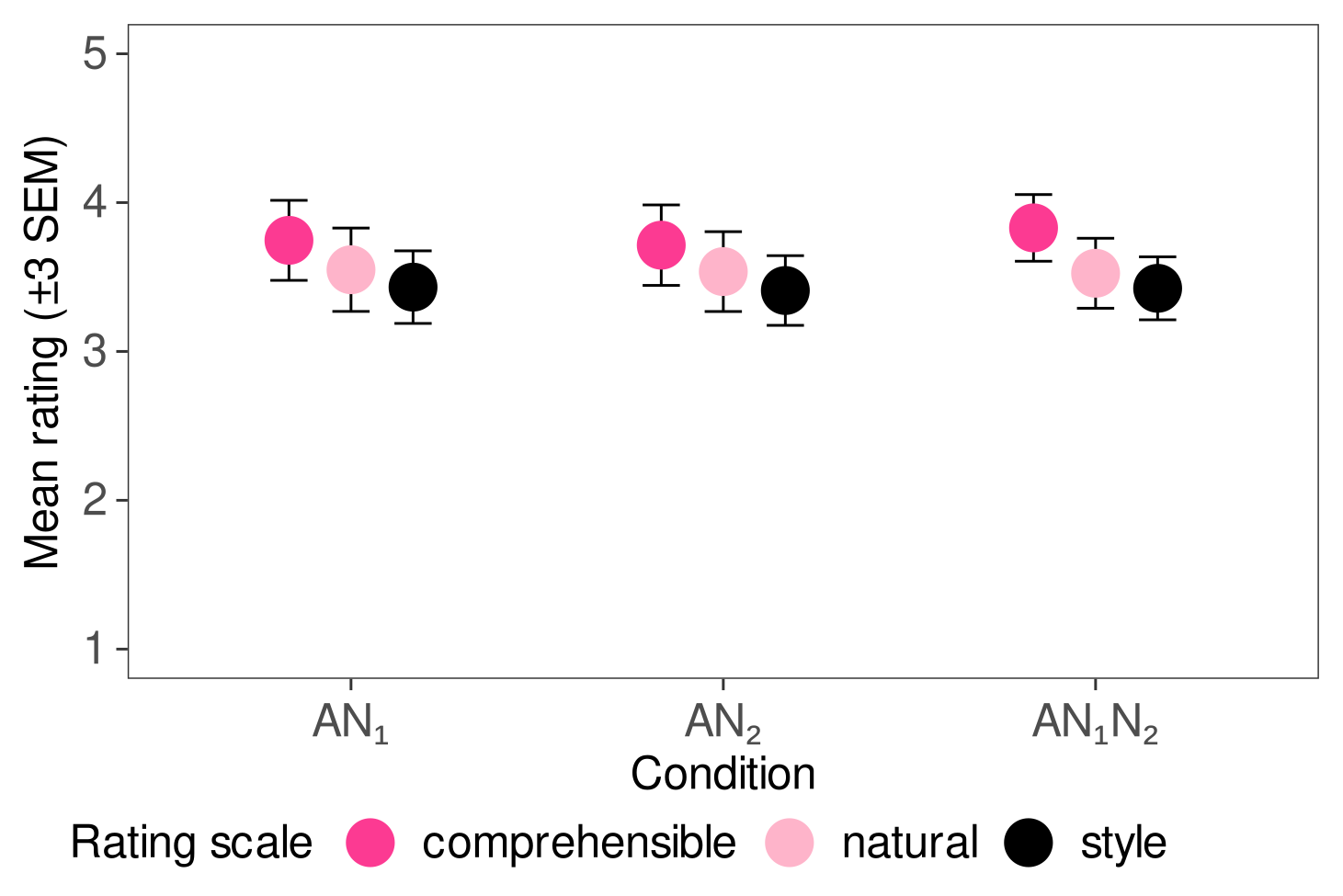
→ We used the mean and scaled it to [0, 1]
Analysis
Annotated the morphosyntactic agreement between the adjective and N1
✔️psychologische Beratungsstelle
✔️königliche Hochzeitsfeier
✔️rustikale Wurstplatte
✔️schwere Unwetterwarnung
❌saurer Kirschbaum
❌steiniger Fahrradweg
❌dreiköpfiger Familienvater
❌vierstöckiger Hausbesitzer
Analysis
AN1N2 ratings as a function of AN1 and AN2 ratings, morphosyntactic match between the adjective and N1, and their 2-way interactions
saurer Kirschbaumrating ~saure Kirscherating vs. saurer Baumrating vs. A-N1 morphosyntactic match
Results
AN1 rating vs. AN2 rating
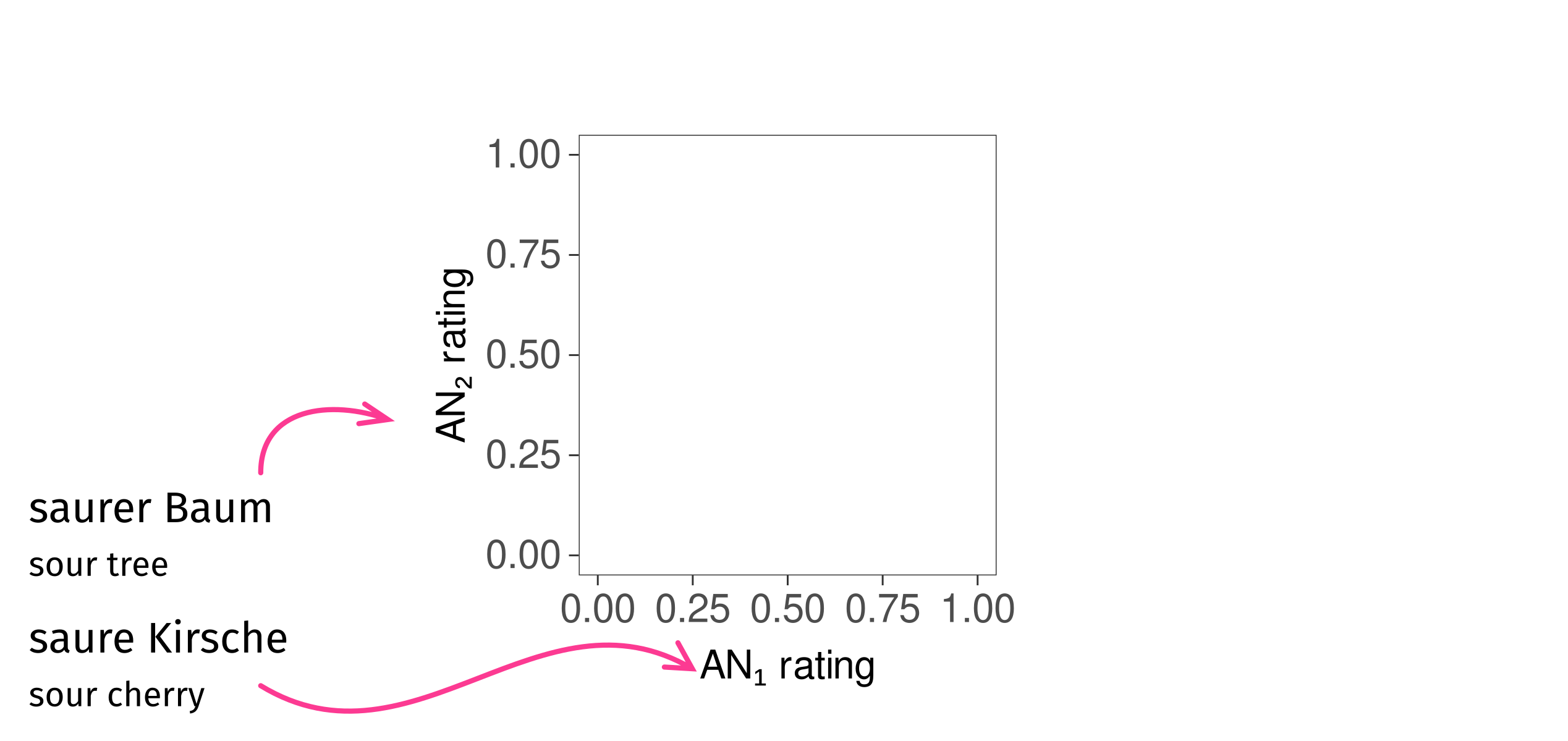
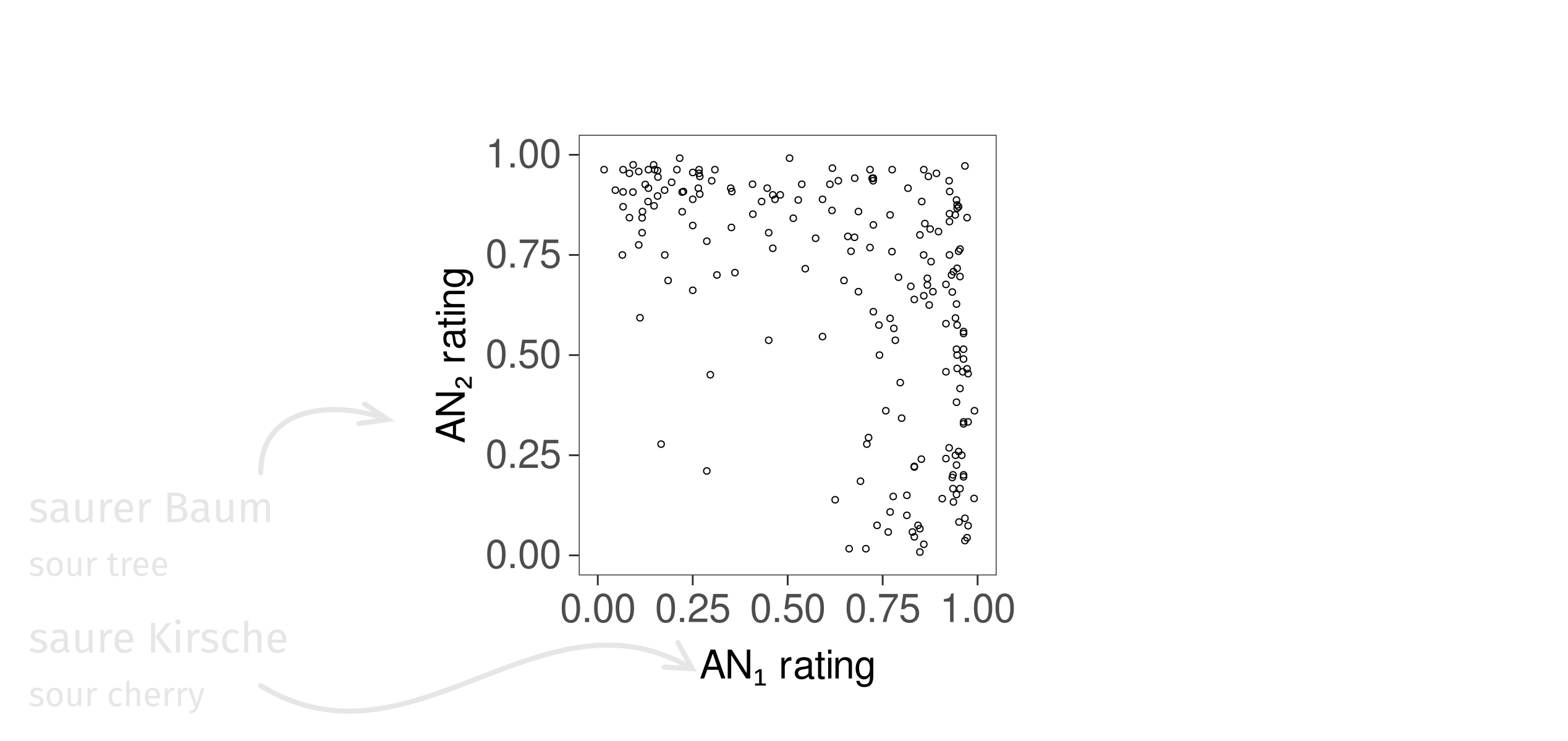
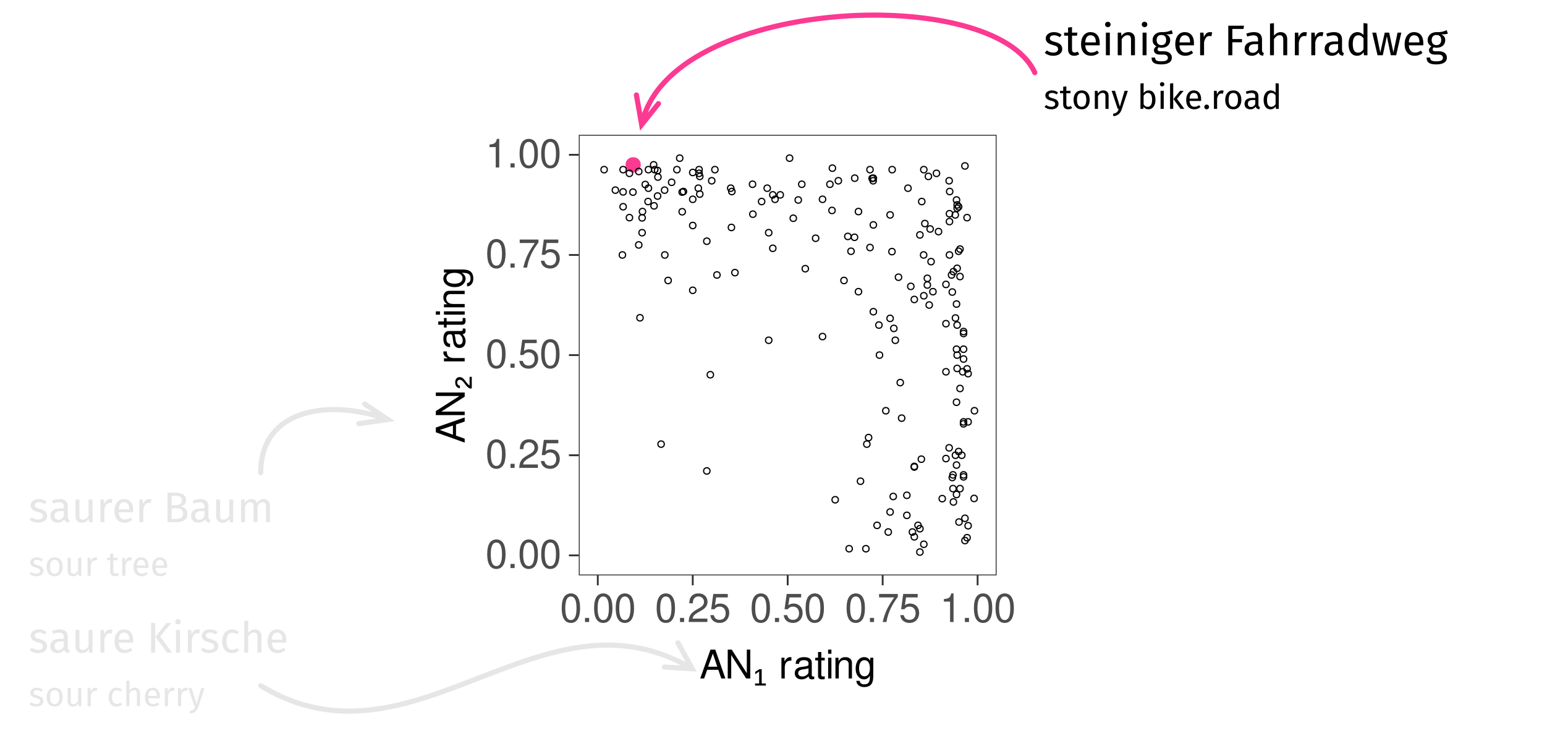
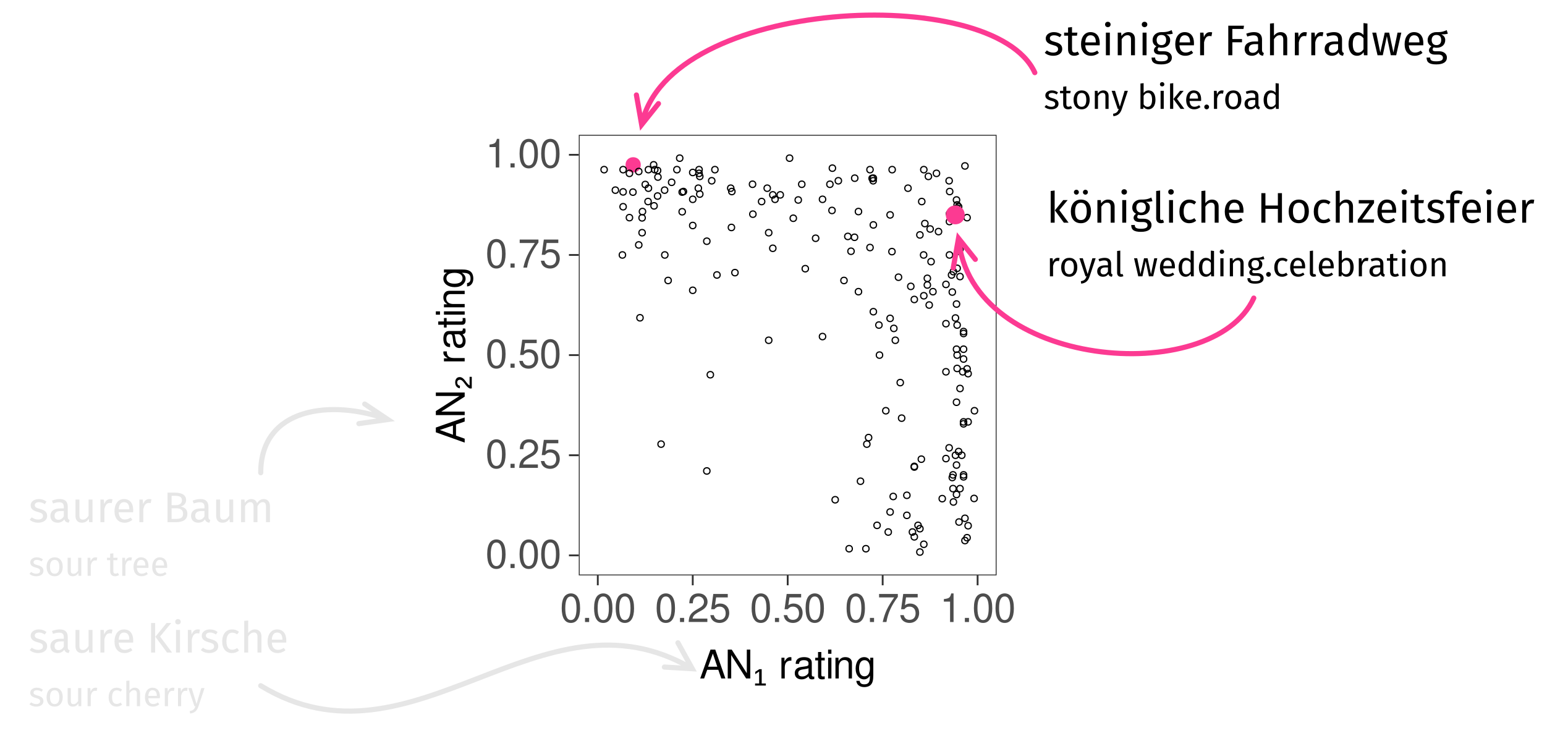

Results
AN1N2 rating vs. AN2 rating

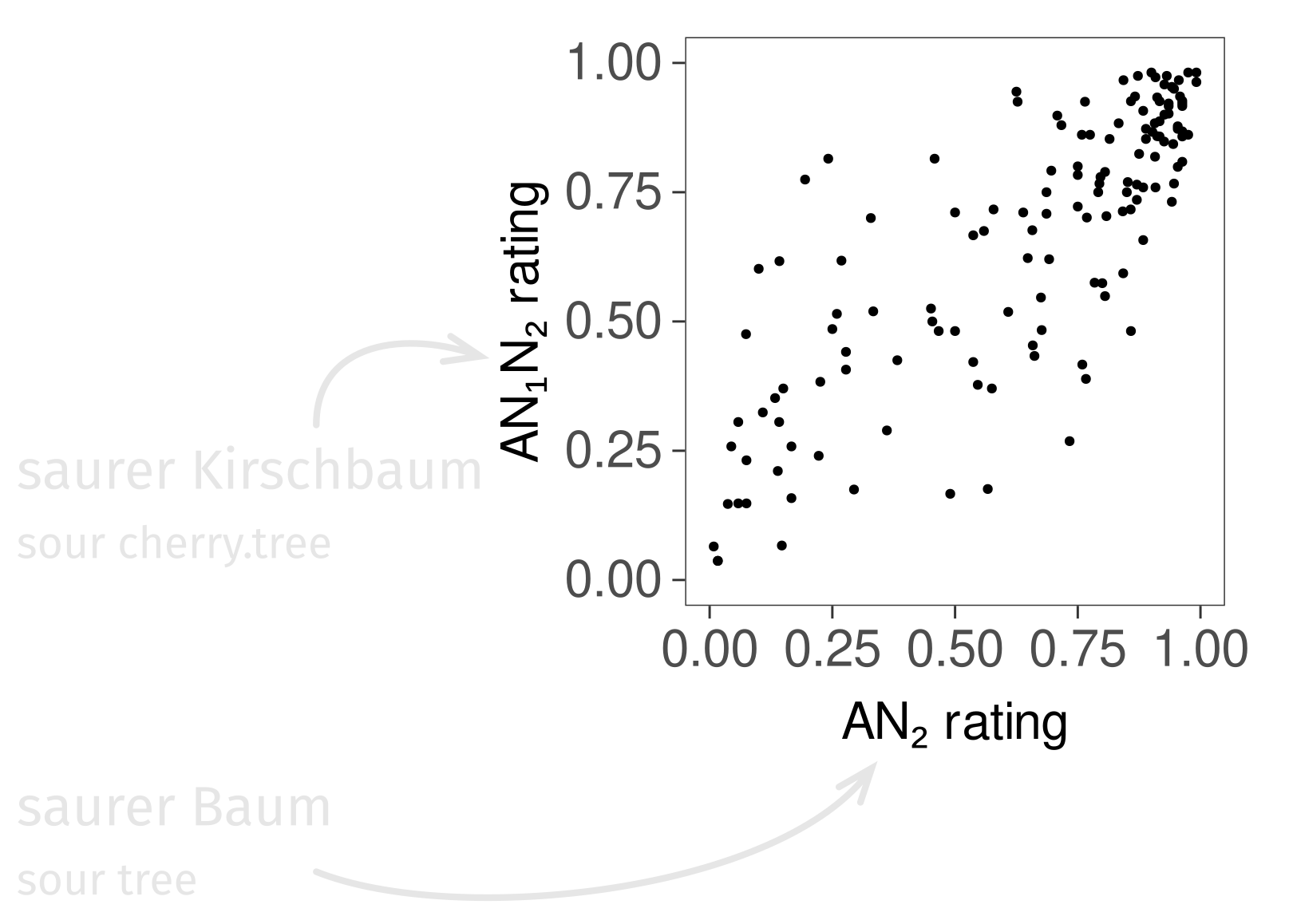
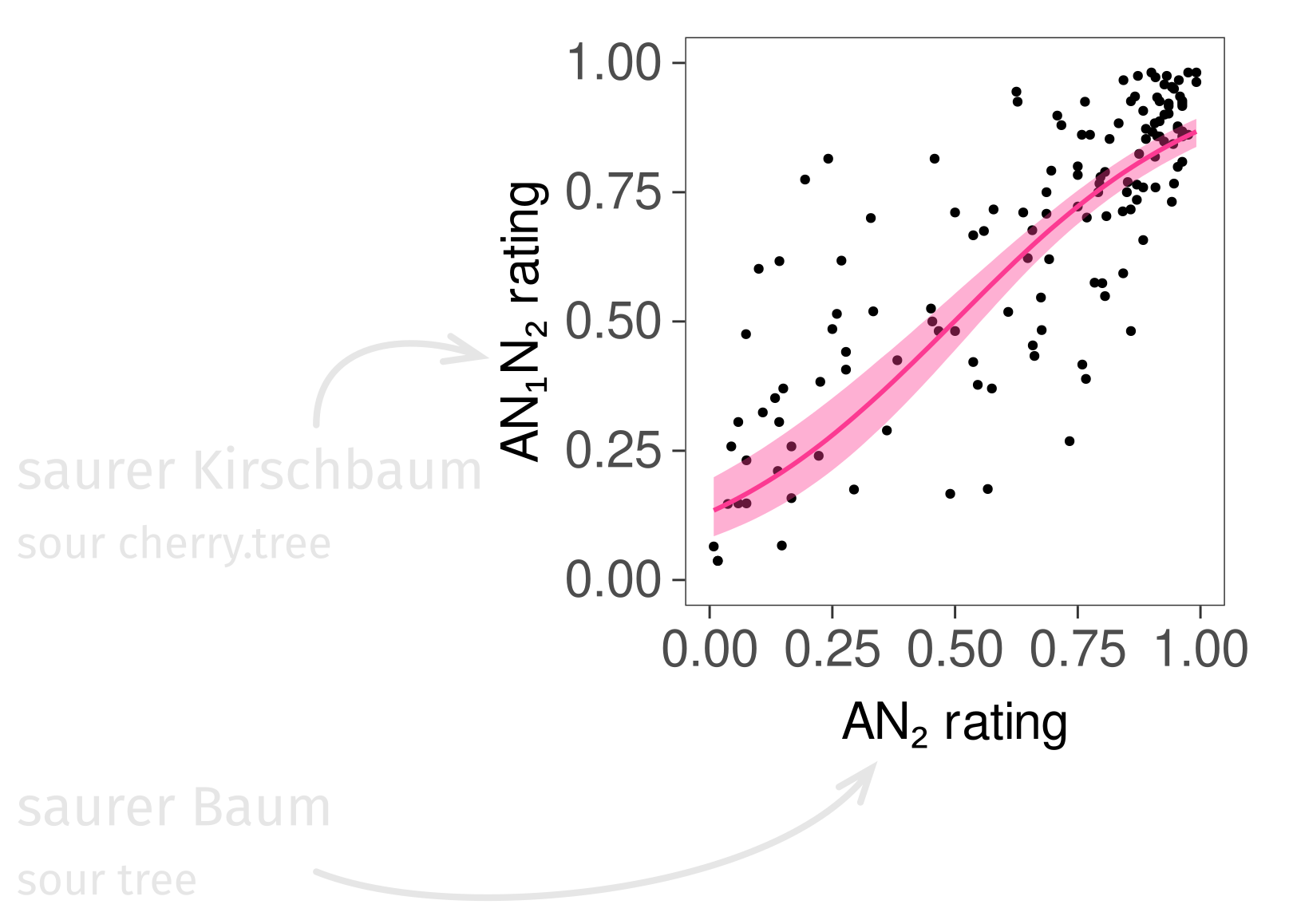
Adjective 🩷 N2 semantically
→ positive effect on AN1N2 rating ✔️
Results
AN1N2 vs. AN1 × AN2 ratings


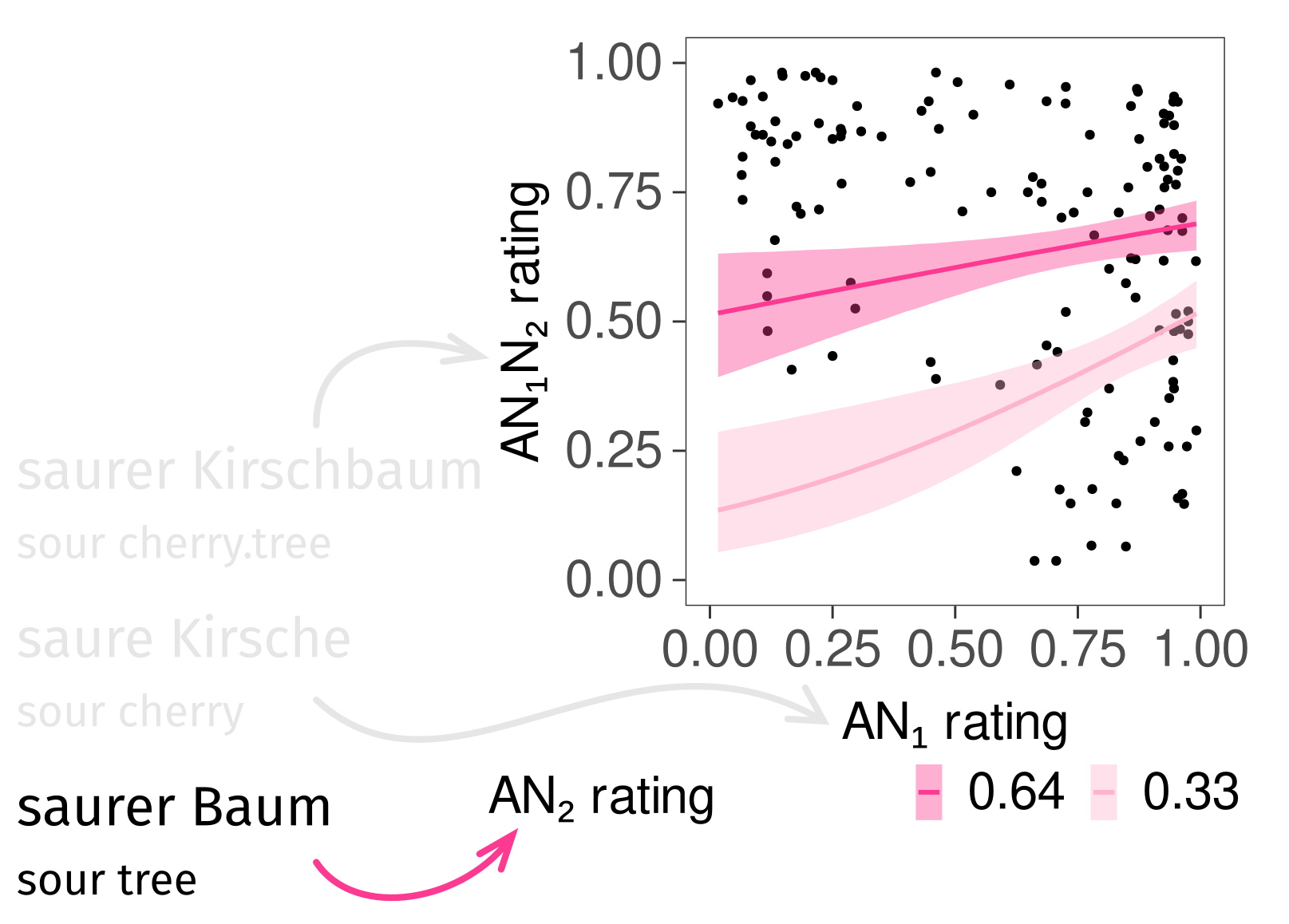
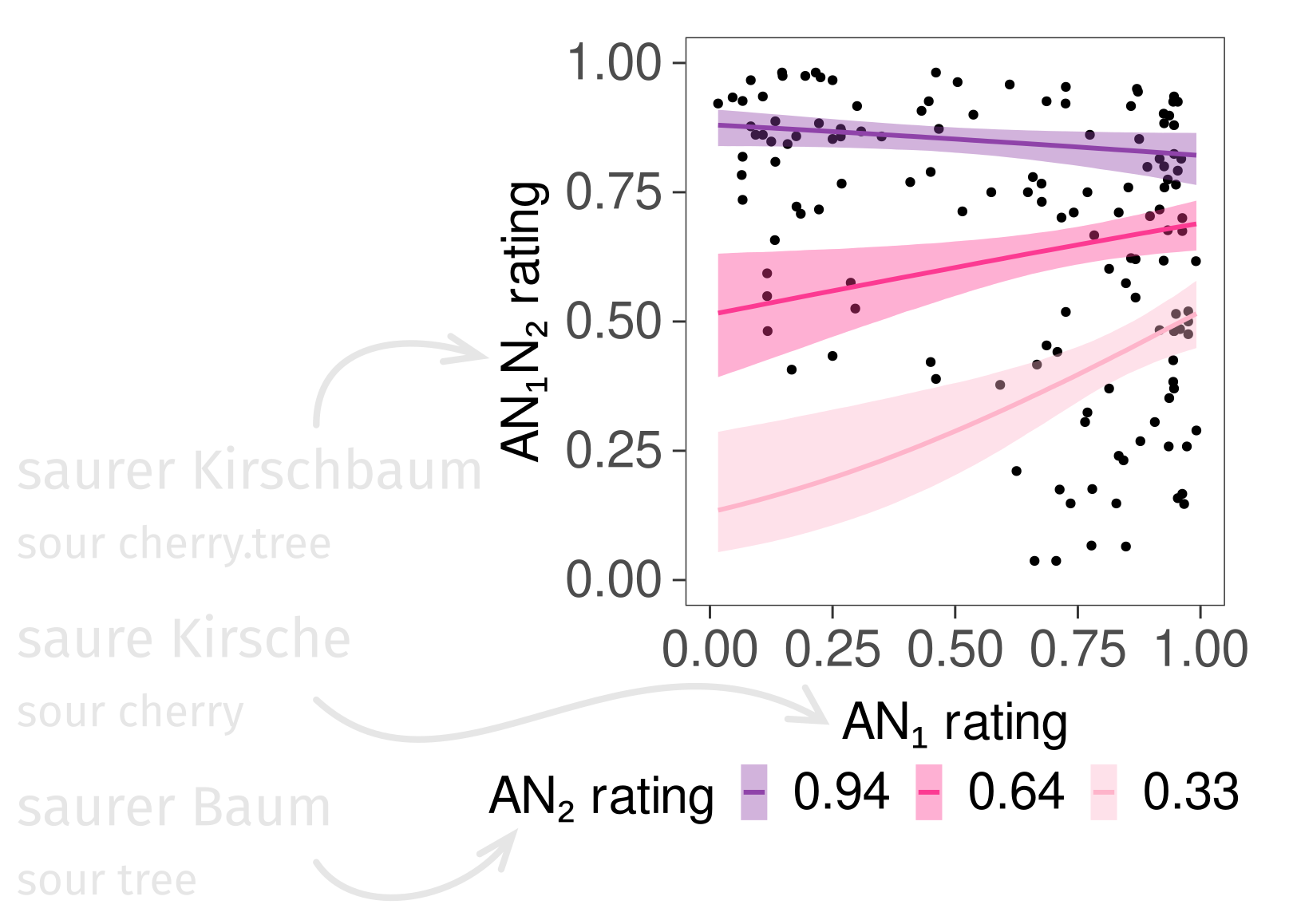
Adjective 🩷 N2 semantically
→ positive effect on AN1N2 rating ✔️
Adjective 🩷 N1 semantically
→ positive effect on AN1N2 rating ❗
N1 🩷 Adjective 🩷 N2 semantically
→ negative effect AN1N2 rating ❗
❔ conflict between the possible attachment sites
Results
A+N1 Morphosyntatic match
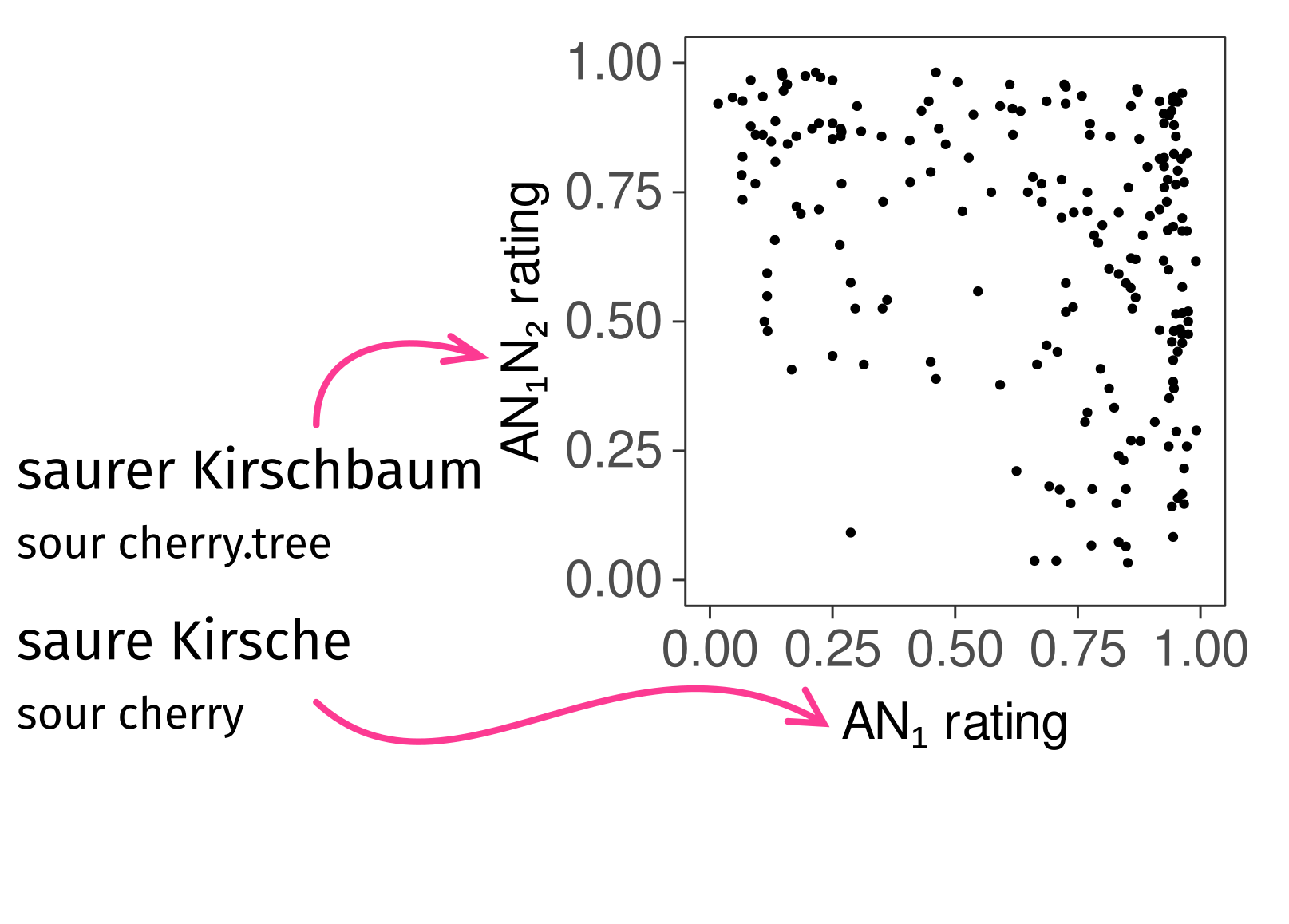
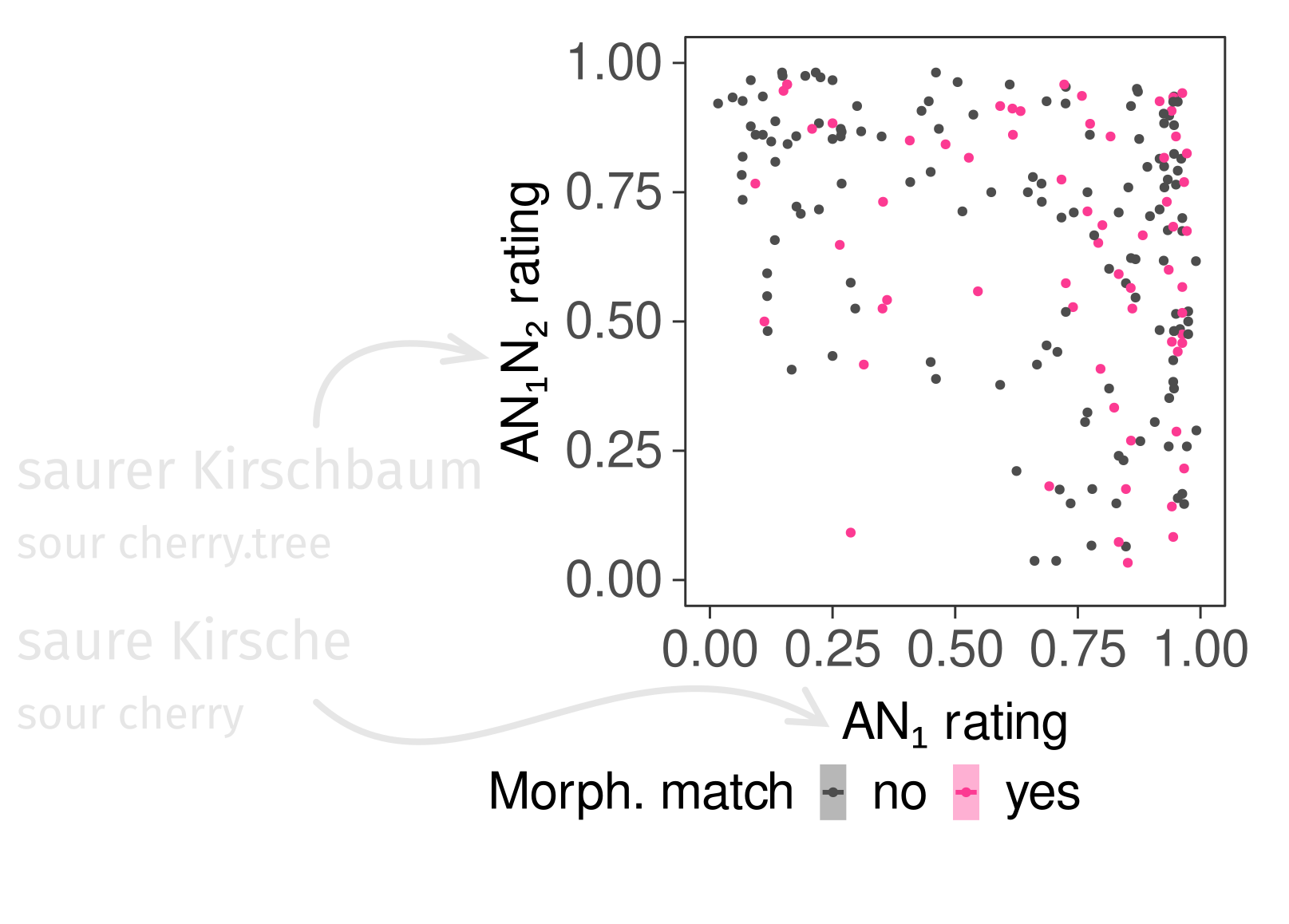
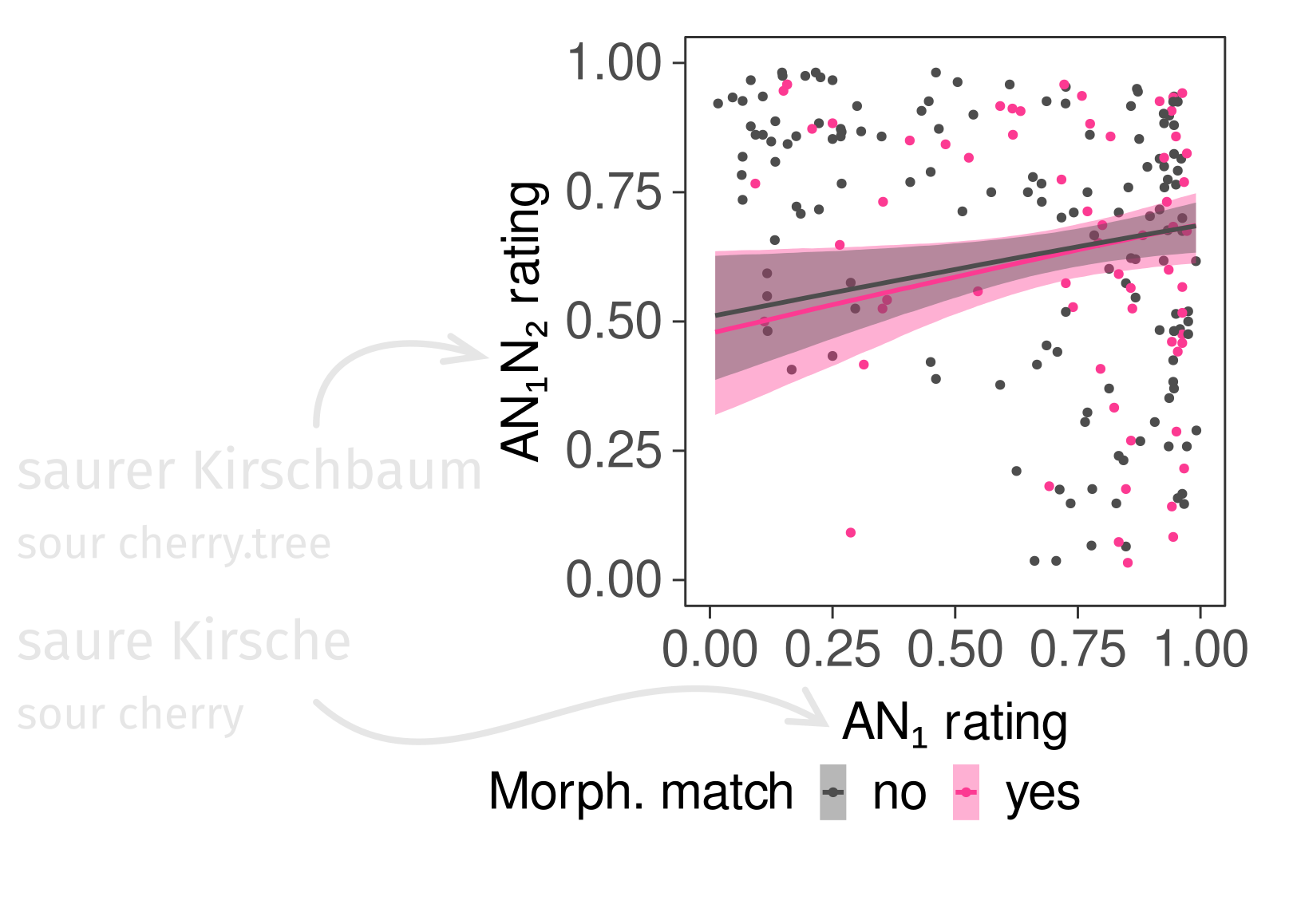
Adjective 🩷 N2 semantically
→ positive effect on AN1N2 rating ✔
Adjective 🩷 N1 semantically
→ positive effect on AN1N2 rating ❗
N1 🩷 Adjective 🩷 N2 semantically
→ negative effect AN1N2 rating ❗
N1 🩷 Adjective 🩷 N2 morphosyntactically
→ no impact on paradox potential ❌
Results
| Est. | Est. error | 95% CrI | |
|---|---|---|---|
| Intercept | −4.05 | 0.77 | −5.61, −2.60 |
| AN1 rating | 3.37 | 0.89 | 1.68, 5.17 |
| AN2 rating | 6.33 | 0.90 | 4.61, 8.13 |
| morph. match | −0.06 | 0.58 | −1.21, 1.09 |
| AN1 rating × AN2 rating | −4.01 | 1.08 | −6.16, −1.92 |
| AN1 rating × morph. match | 0.14 | 0.48 | −0.80, 1.11 |
| AN2 rating × morph. match | −0.12 | 0.51 | −1.10, 0.88 |
Discussion
Though both nouns have a positive influence on the compound’s acceptability, their effects are not strictly additive.
→ neidischer Zickenkrieg jealous bitch.war❔
In the absence of a suitable (N2) head noun candidate, the first noun (N1) becomes an attractive target for the adjective.
The comprehensibility, naturalness and stylistic form ratings were highly correlated, indicating that they record similar concepts.
There was no evidence for an effect of morphosyntactic match between adjective and N1.
Experiment 2
Which noun in a compound is modified by the adjective?
Predictions
Grammar: the adjective is always the attribute of N2
When N2 is chosen more often than N1 → canonical
When N1 is chosen more often than N2 → bracketing paradox
When N1 is chosen as often as N2 → ambiguous
When ? is chosen often → 🚫 interpretation?
When adjective 🩷 N1 morphosyntactically → adjective attaches more easily to N1
The semantic compatibility ratings from Experiment 1 should align with the selected attachment site.
Analysis
Rate of N1 attachment as a function of the corresponding AN1 and AN2 ratings from Experiment 1, morphosyntactic match between the adjective and N1, and their 2-way interactions
saurer Kirschbaumattachment ~ saure Kirscherating vs. saurer Baumrating vs. A-N1 morphosyntactic match
Results
Attachment preference
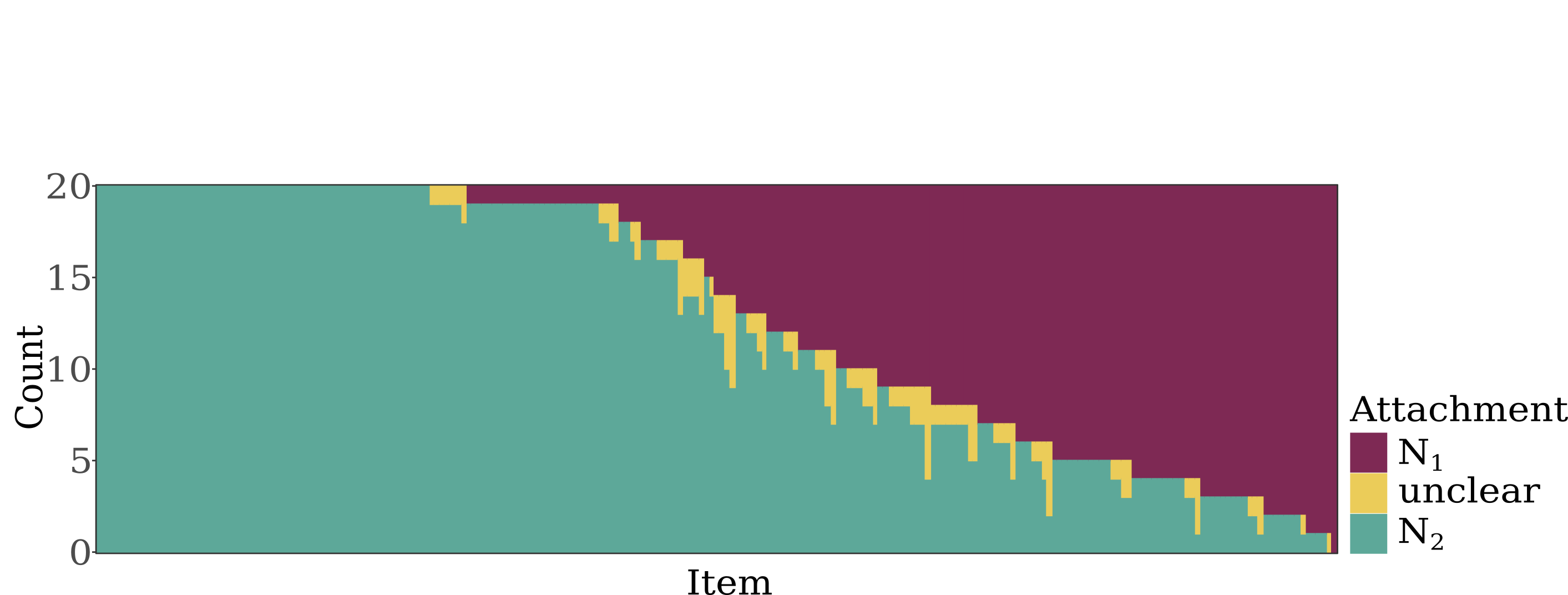
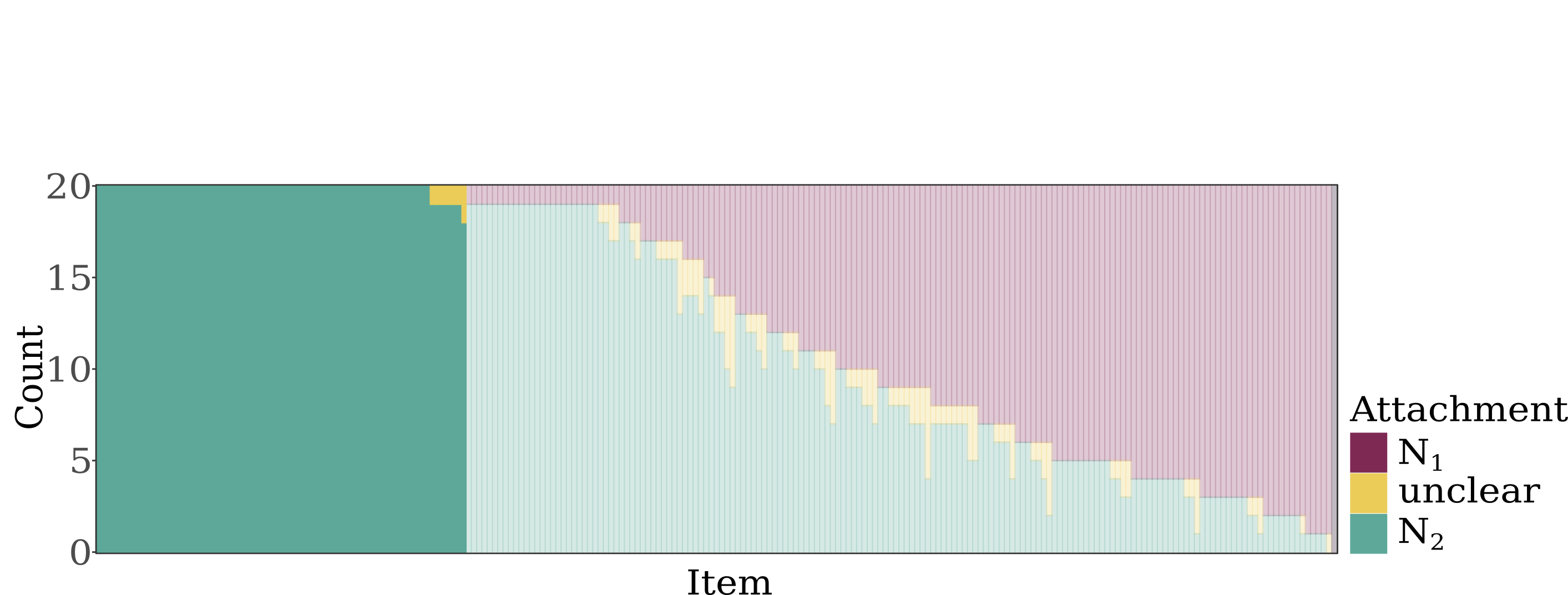
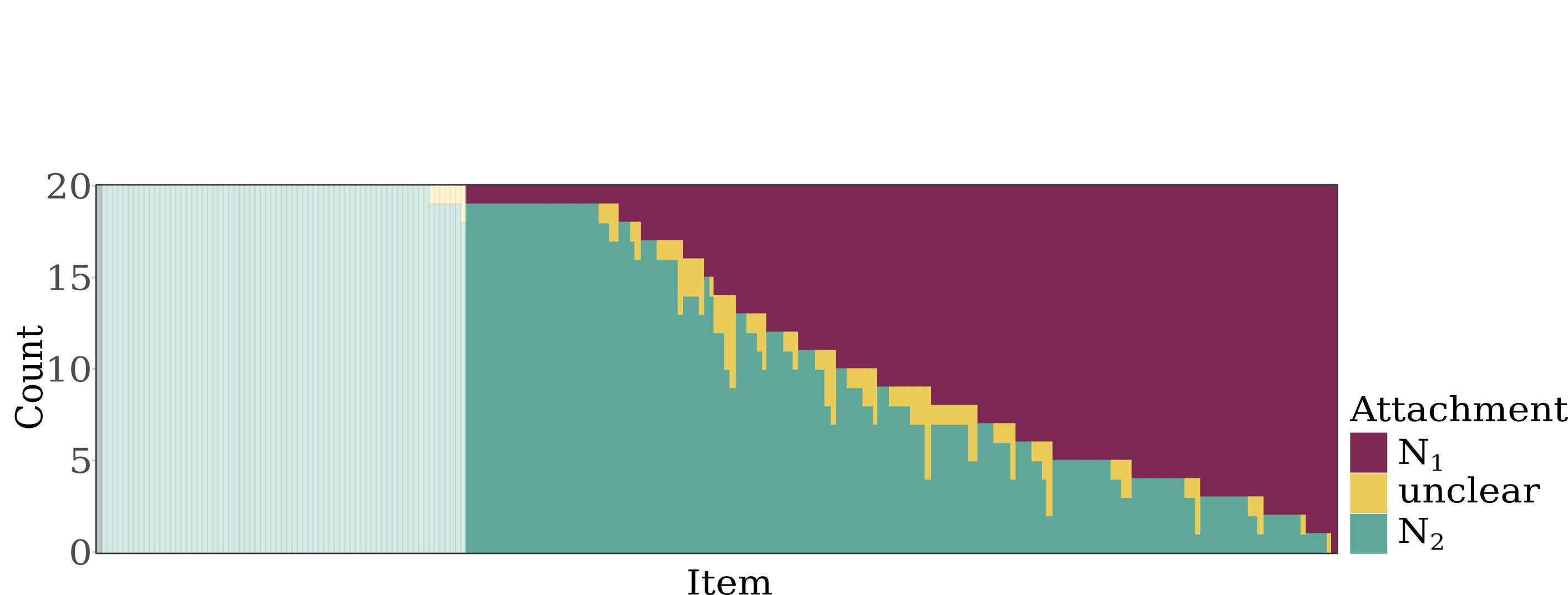
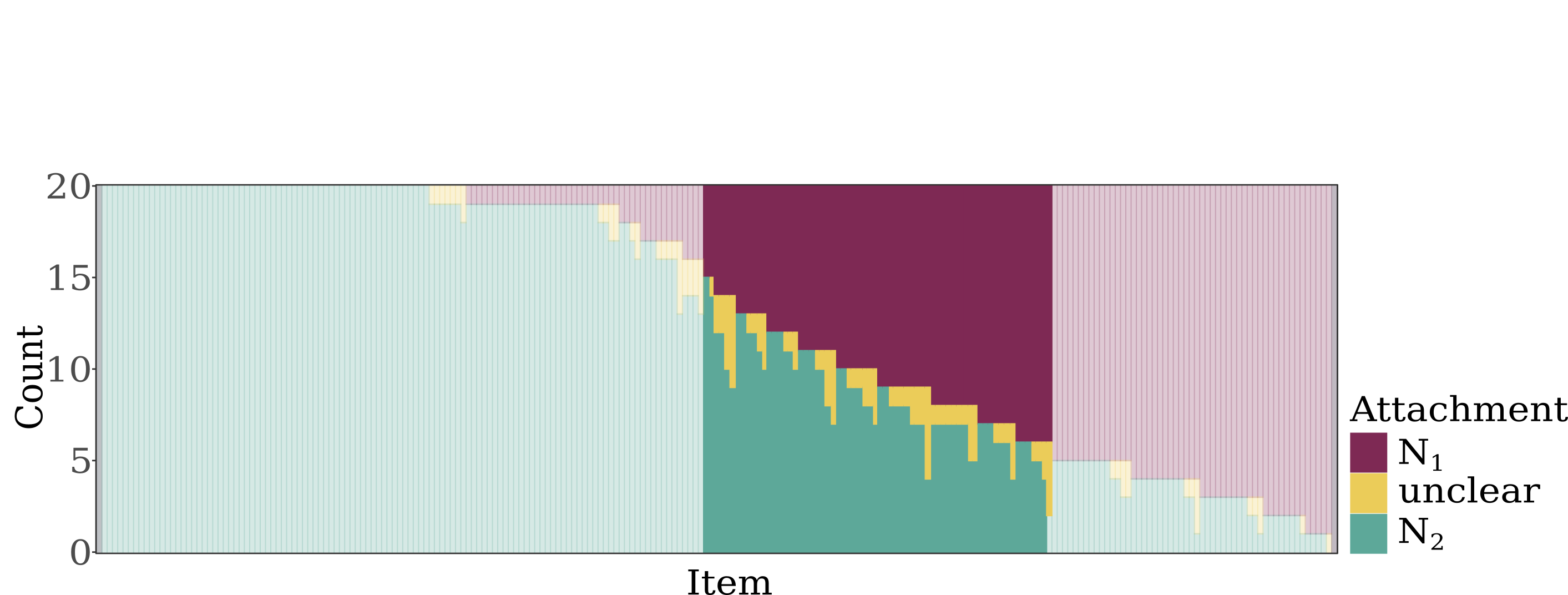


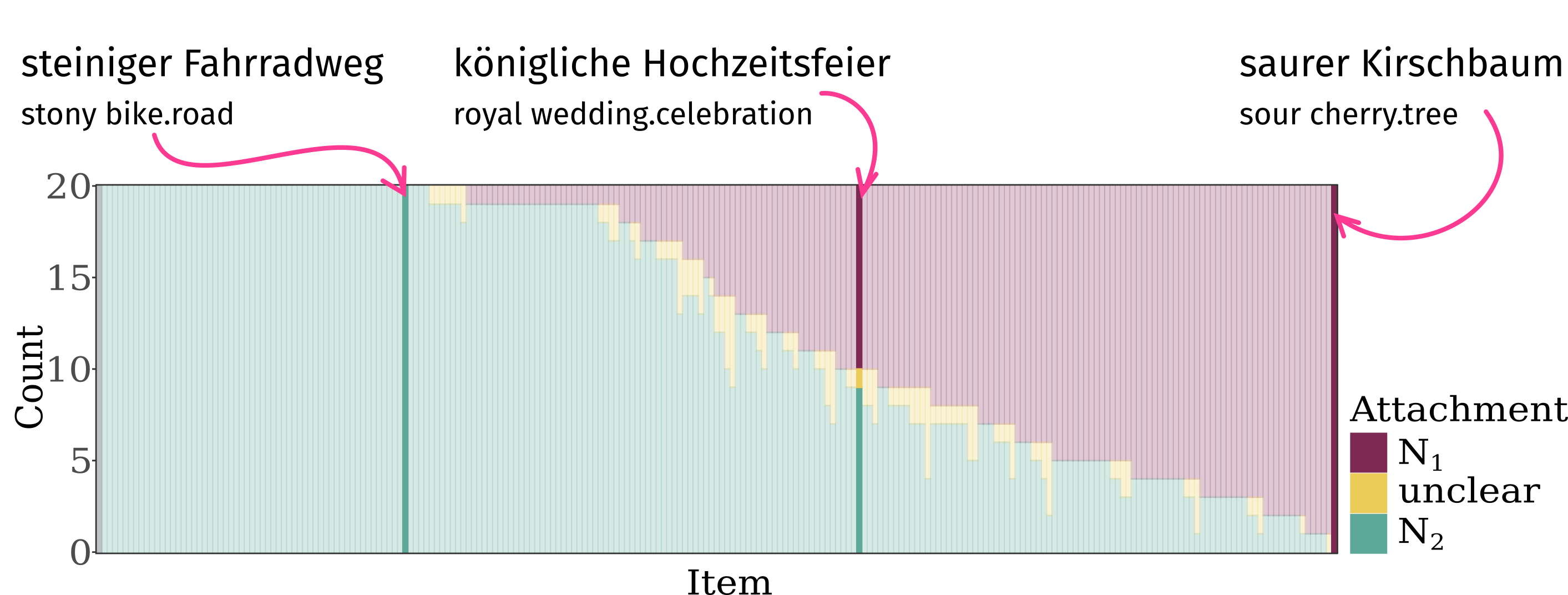
Grammatically: the adjective is always the attribute of N2 ❌
N2 was chosen more often than N1 overall → grammatical ✔️
N1 was sometimes chosen over N2 → bracketing paradox ✔️
When ? is chosen often → 🚫 interpretation?
Results
Attachment preference
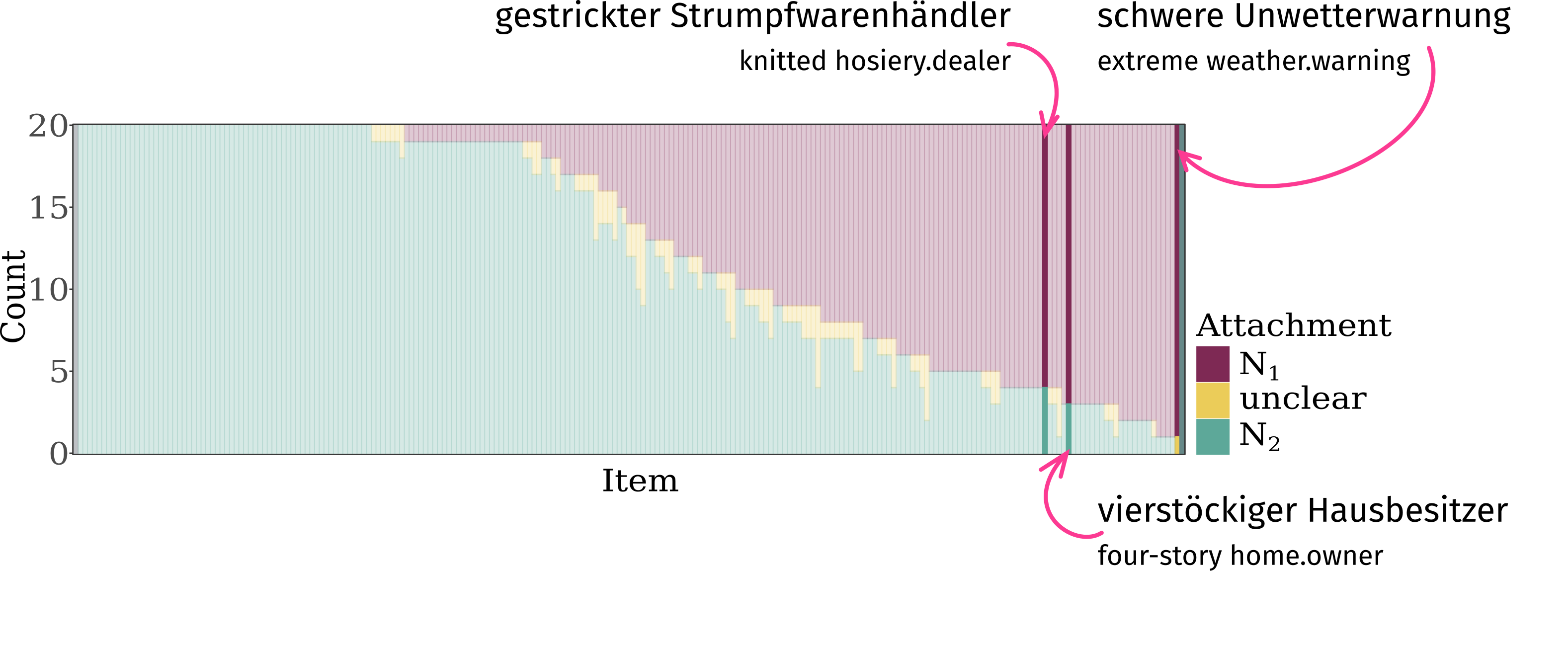

The prime bracketing paradox examples from linguistic literature weren’t overwhelmingly N1 ❗
Abramov, B. (1992). Nochmals zur “reitenden Artilleriekaserne”. In R. Grosse, G. Lerchner, & M. Sehröder (Eds.), Beiträge zur Phraseologie, pp. 133–139. Bergmann, R. (1980). Verregnete Feriengefahr und Deutsche Sprachwissenschaft. Sprachwissenschaft, 5(3), 234–265. Burkhardt, A. (1999). Gut erhaltene Knochenfunde beim Urmenschen. Sprachreport, 15(2), 2–10. Maienborn, C. (2020). Wider die Klammerparadoxie. Zeitschrift für Sprachwissenschaft, 39(2), 149–200.
How much N1 attachment makes a bracketing paradox❔
Results
N1 attachment vs. AN2 rating
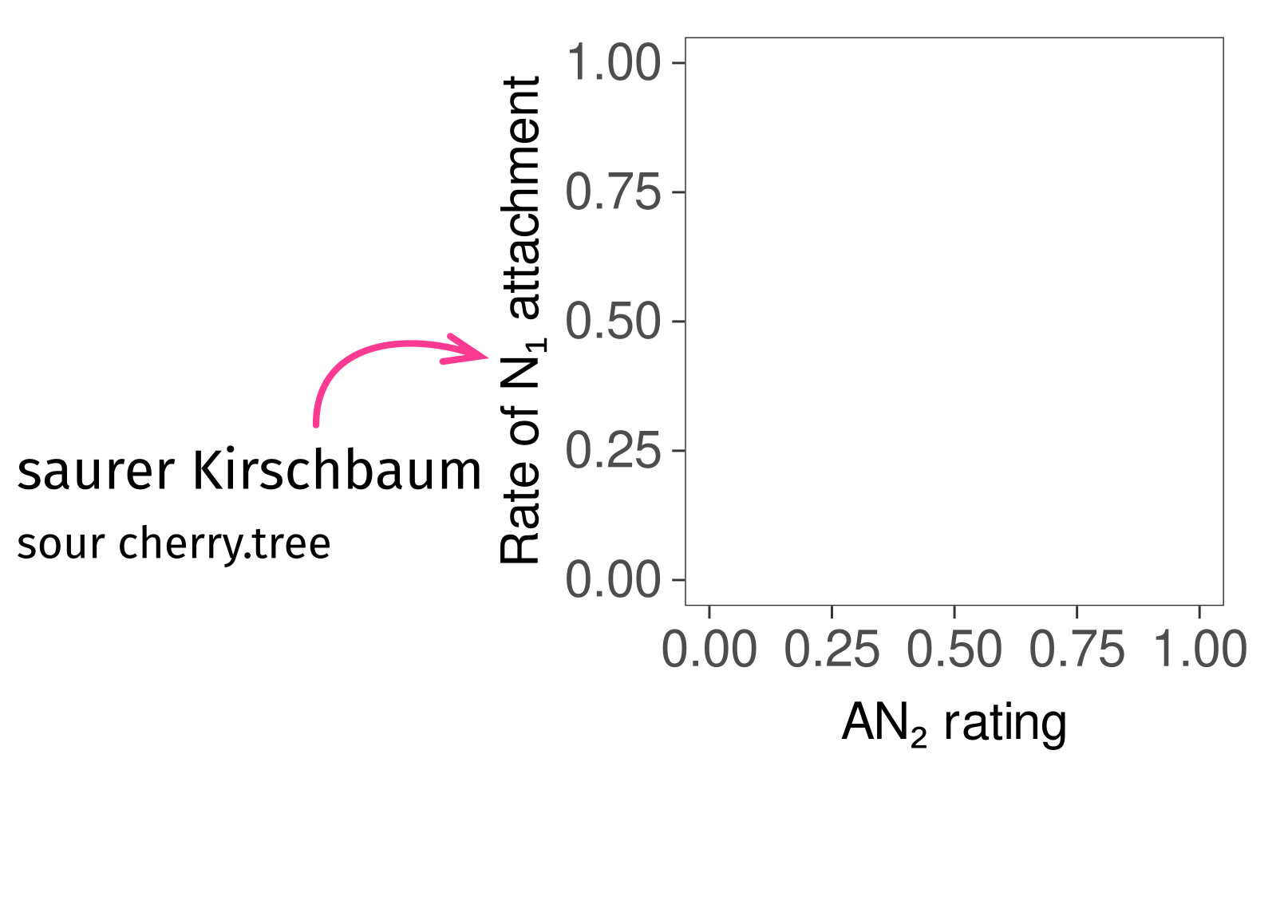

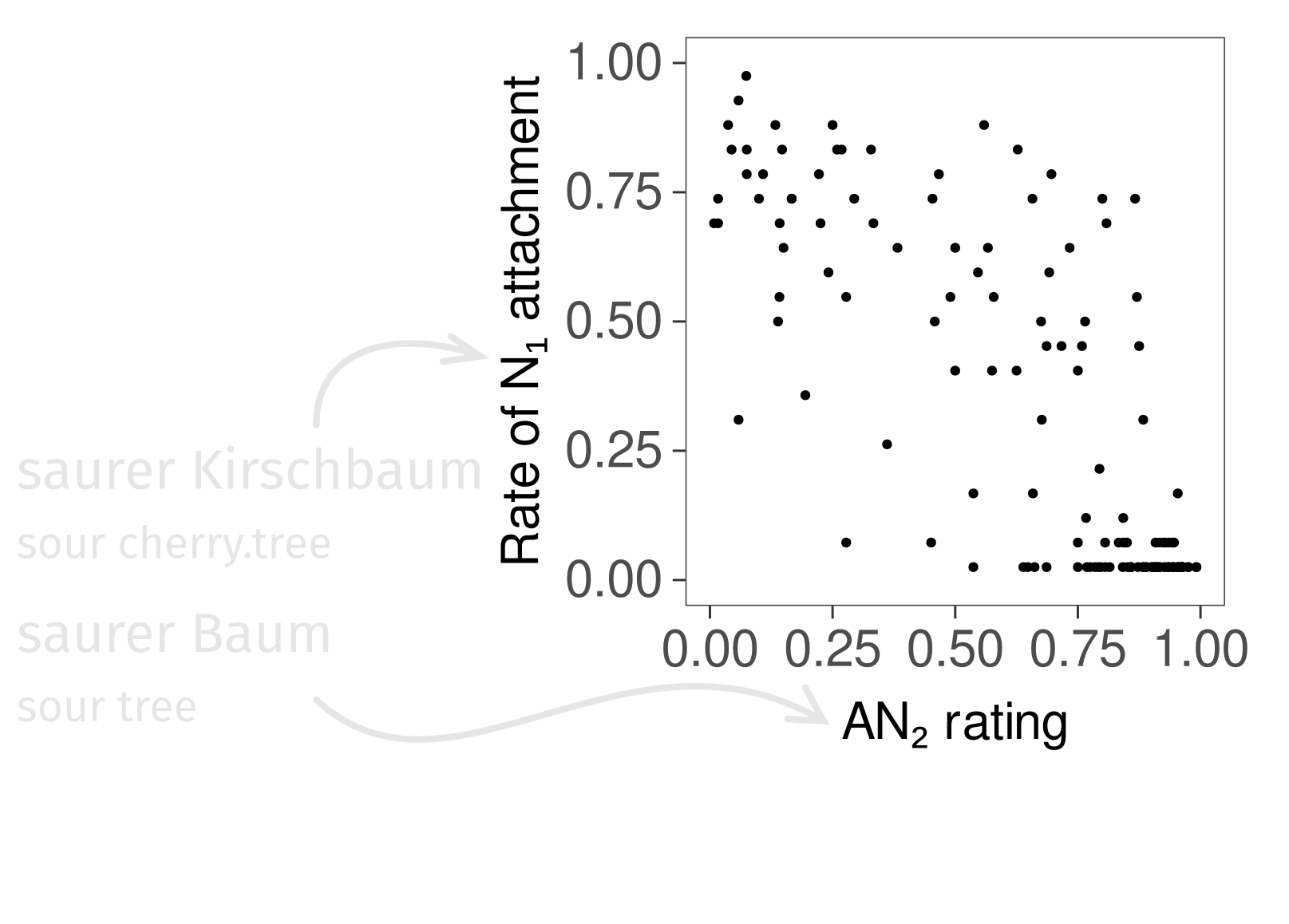

Grammatically: the adjective is always the attribute of N2 ❌
N2 was chosen more often than N1 overall → grammatical ✔️
N1 was sometimes chosen over N2 → bracketing paradox ✔️
When ? is chosen often → 🚫 interpretation?
The compatibility ratings from Experiment 1 align with the selected attachment site. ✔️
High adjective 🩷 N2 semantic match reduced N1 attachments.
Results
N1 attachment vs. AN1 × AN2 rating
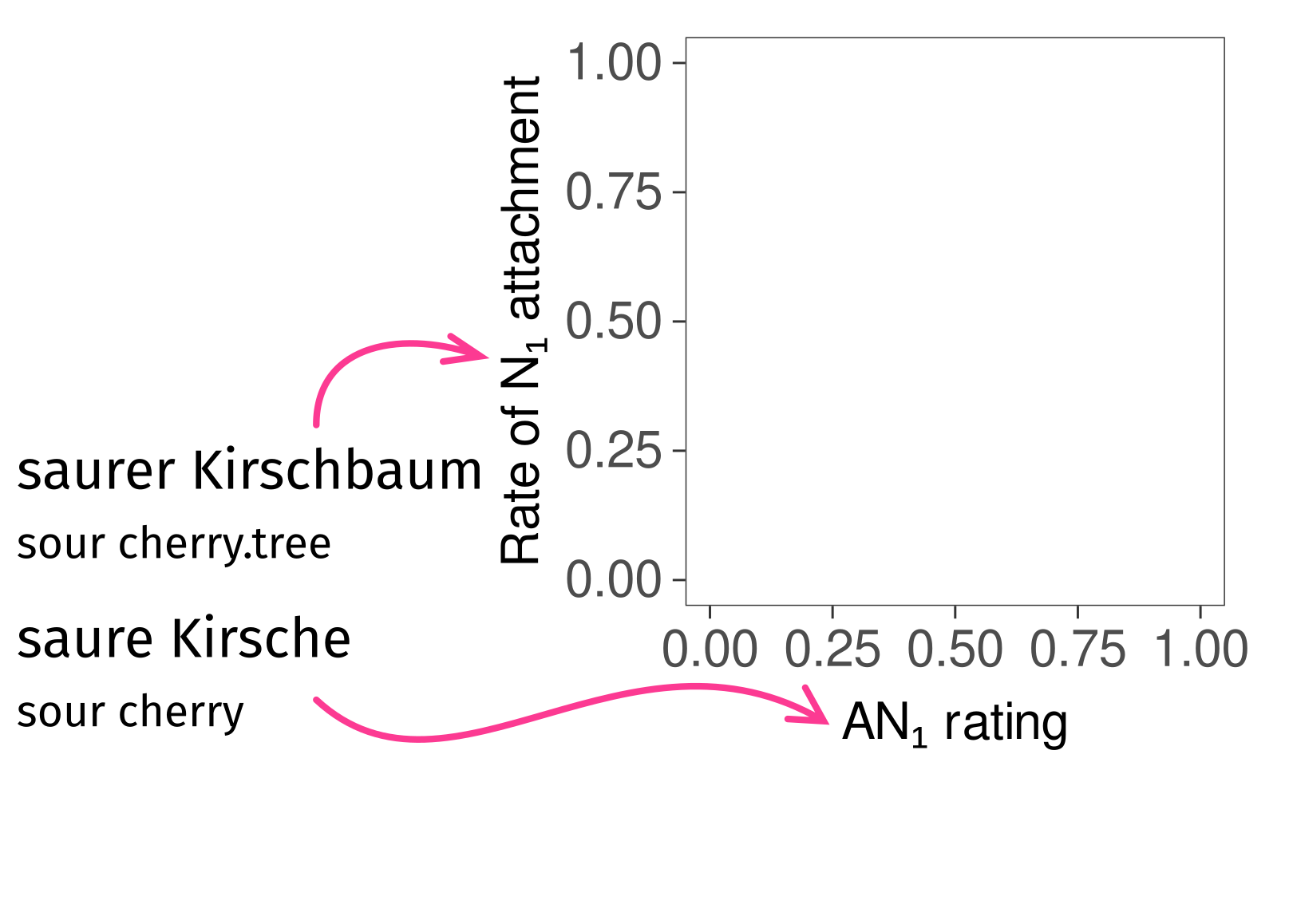
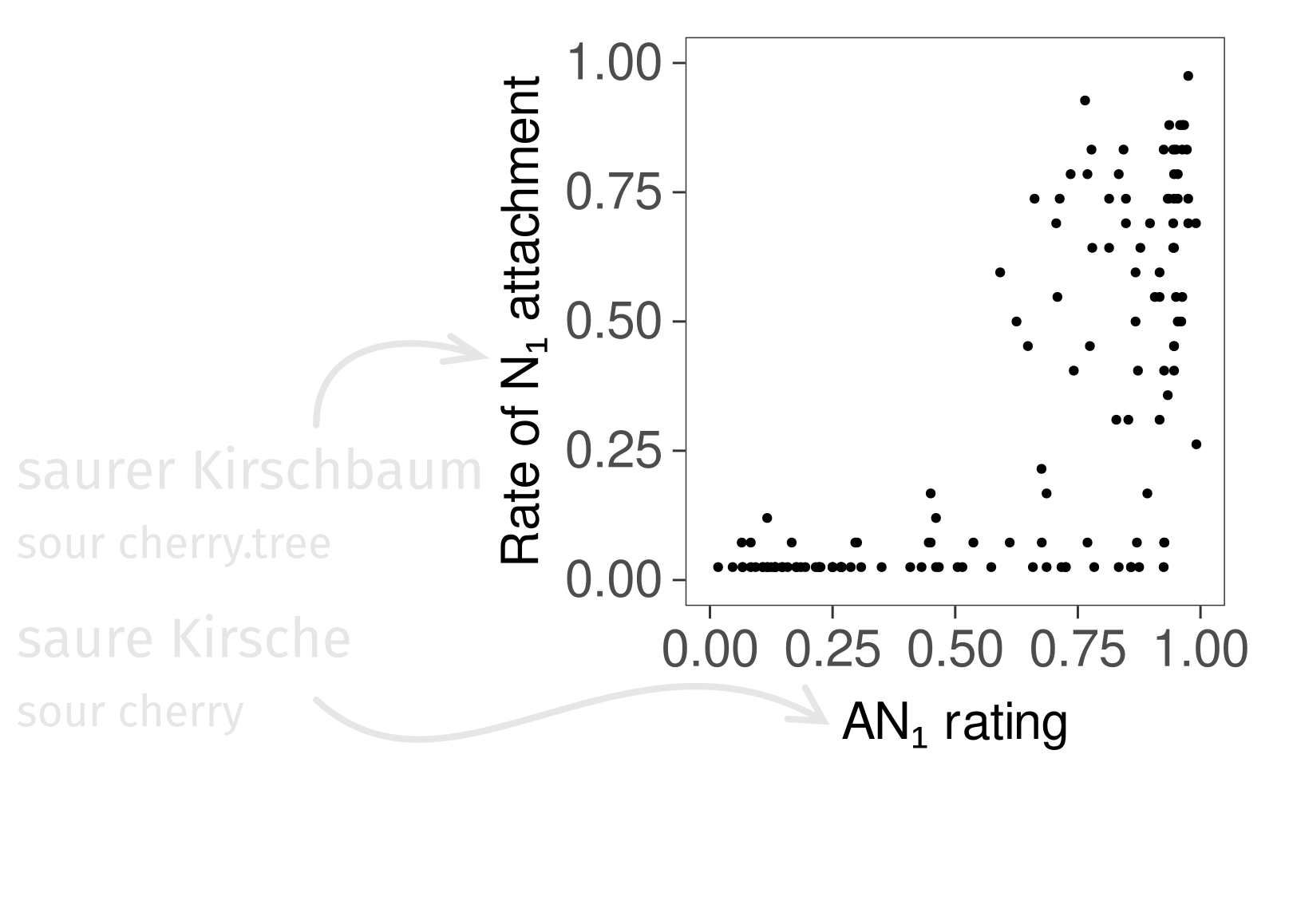
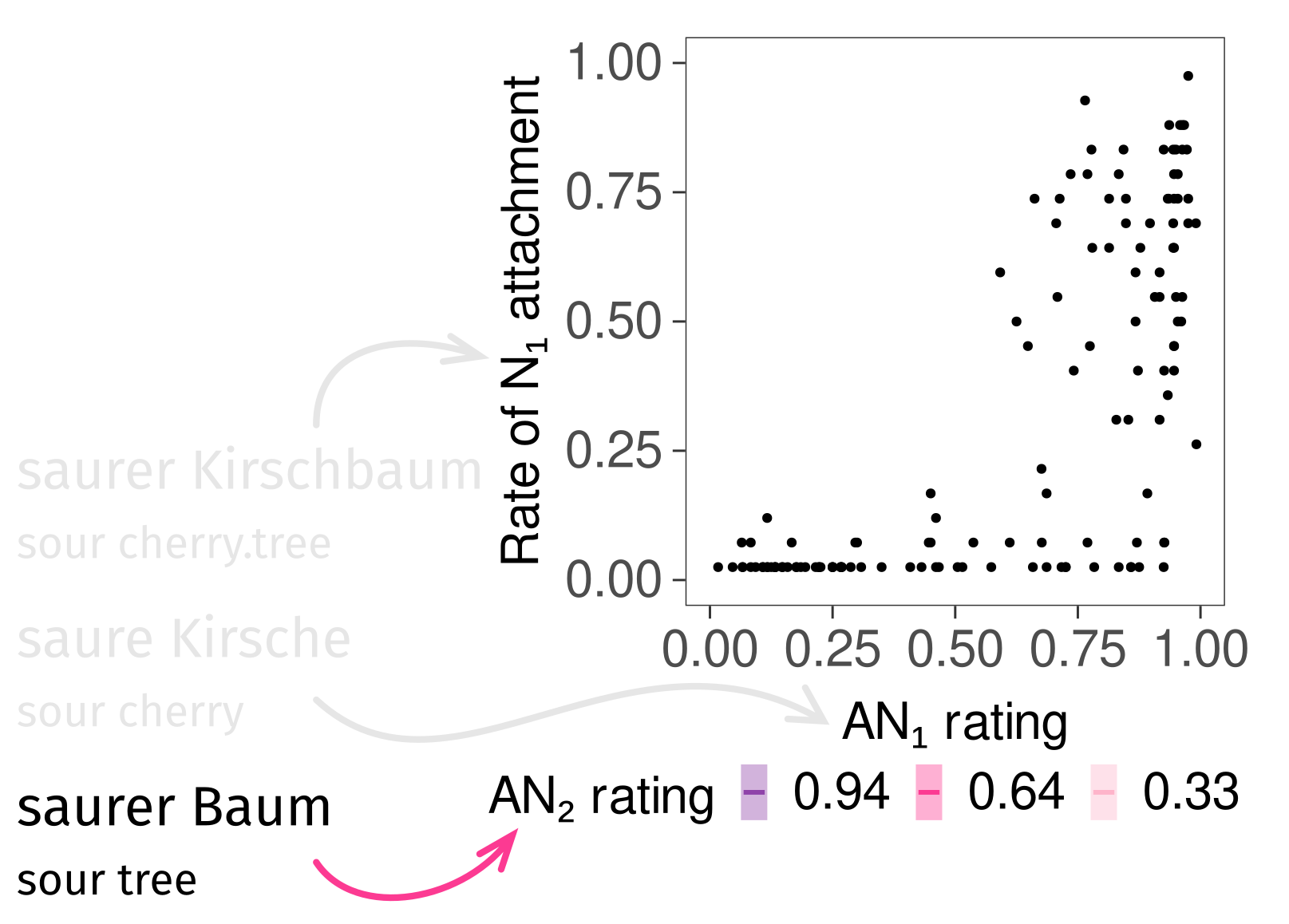

Grammatically: the adjective is always the attribute of N2 ❌
N2 was chosen more often than N1 overall → grammatical ✔️
N1 was sometimes chosen over N2 → bracketing paradox ✔️
When ? is chosen often → 🚫 interpretation?
The compatibility ratings from Experiment 1 align with the selected attachment site. ✔️
High adjective 🩷 N2 semantic match reduced N1 attachments
High adjective 🩷 N1 semantic match increased N1 attachments
Adjective 🩷 N1 match had a bigger effect when
adjective 🩷 N2 match was poor.
Results
A+N1 Morphosyntactic match
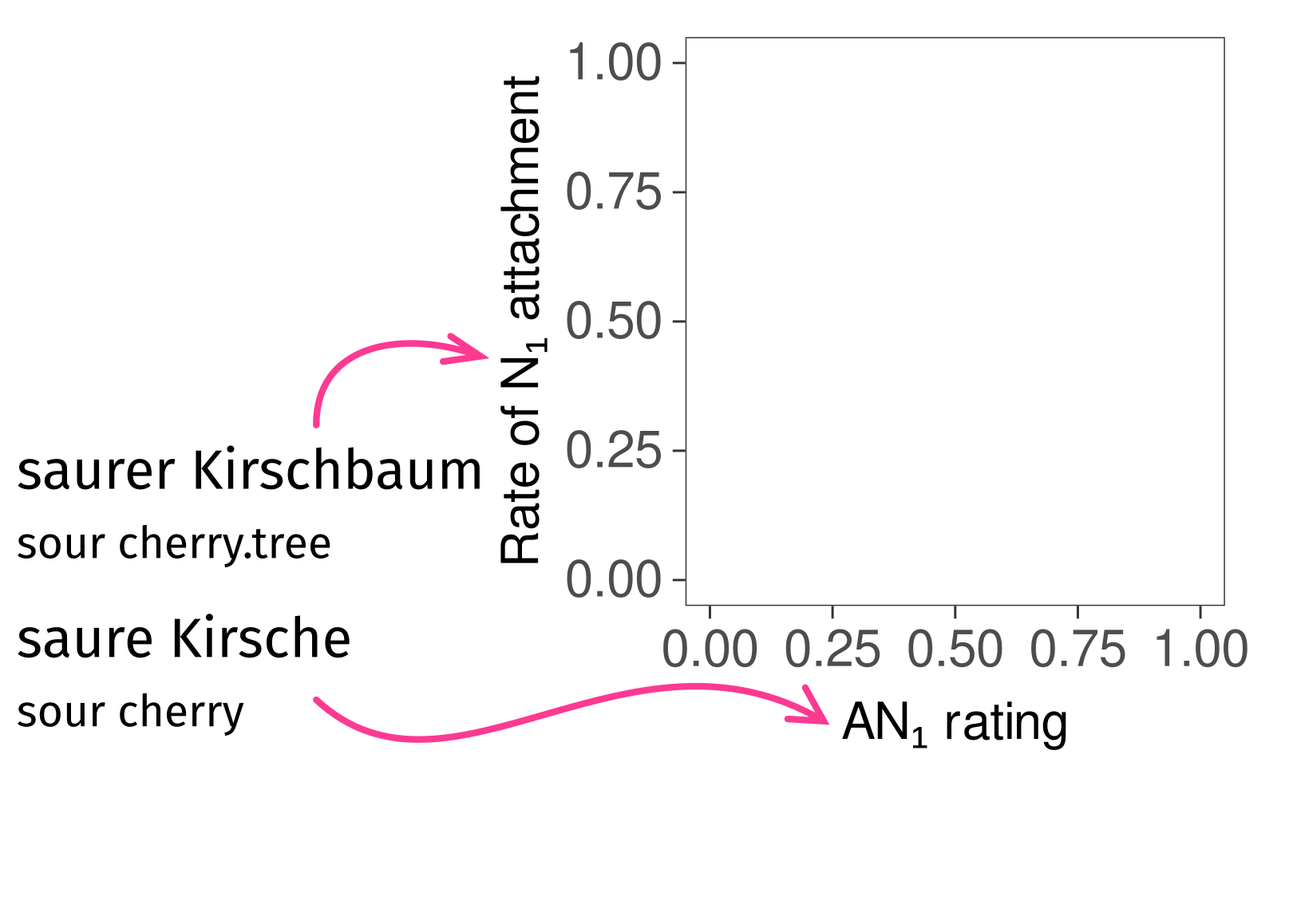
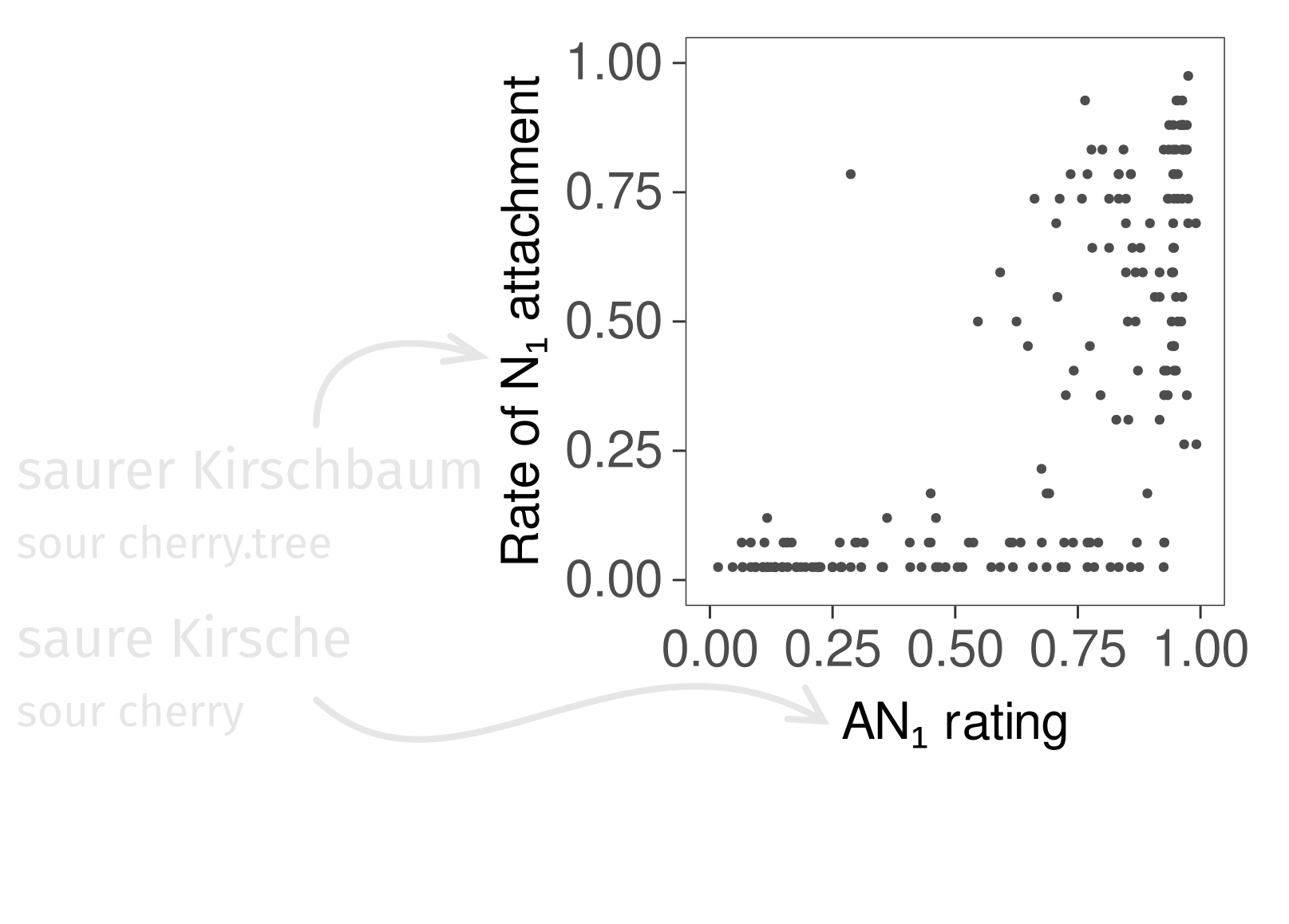

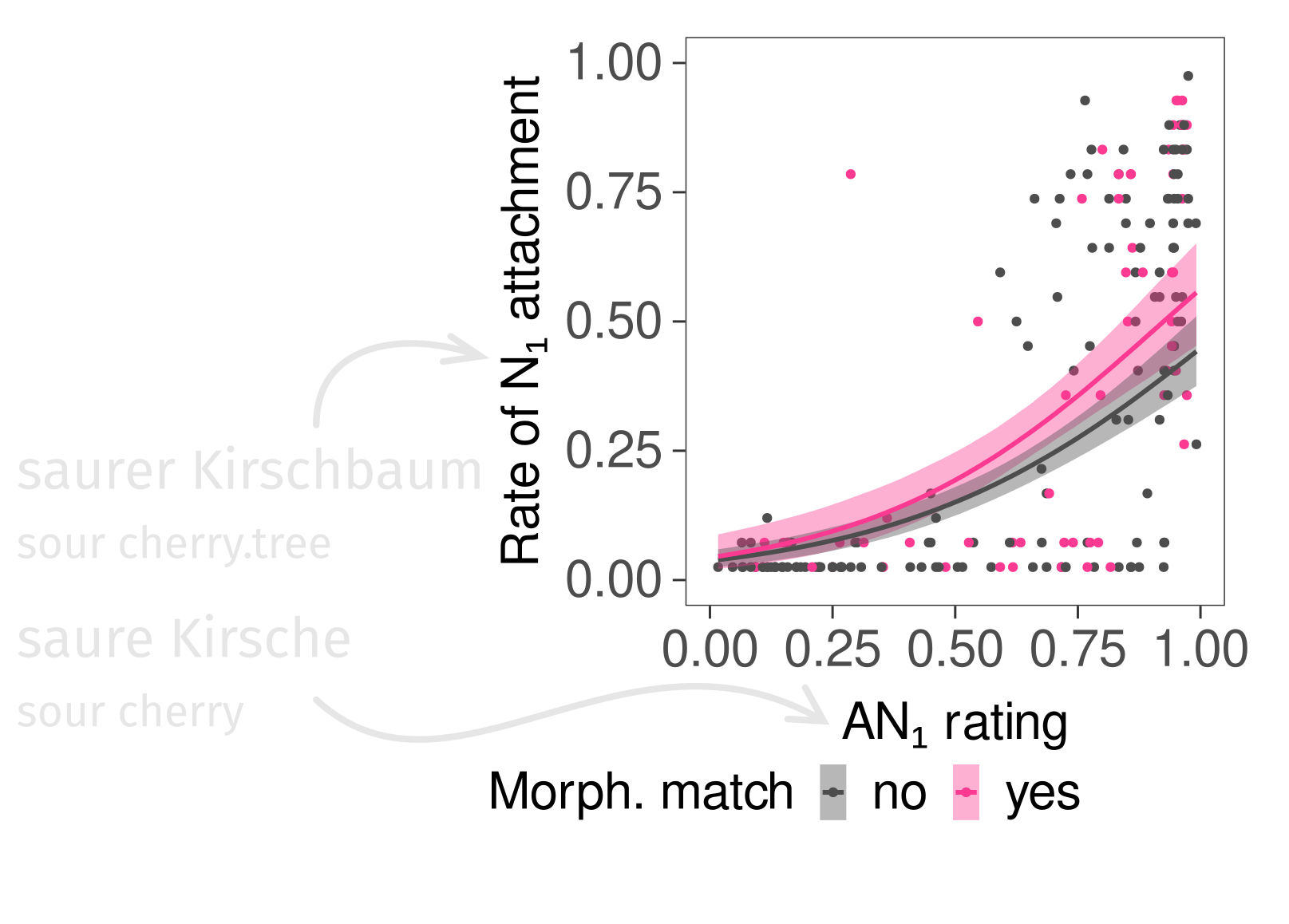
Results
| Est. | Est. error | 95% CrI | |
|---|---|---|---|
| Intercept | −1.95 | 0.75 | −3.42, −0.50 |
| AN1 rating | 4.00 | 0.85 | 2.32, 5.69 |
| AN2 rating | −1.92 | 0.82 | −3.53, −0.29 |
| morph. match | −0.24 | 0.65 | −1.51, 1.04 |
| AN1 rating × AN2 rating | −1.25 | 0.97 | −3.17, 0.65 |
| AN1 rating × morph. match | 0.31 | 0.56 | −0.76, 1.43 |
| AN2 rating × morph. match | 0.61 | 0.57 | −0.51, 1.70 |
Discussion
Participants did not opt out of interpreting the phrases.
Most phrases were judged in accordance with grammar → N2.
N1 was a viable attachment site for a large group of phrases.
There were few unequivocal bracketing paradoxes.
The participants disagreed on the interpretation of a substantial group of phrases.
The results are in line with Experiment 1.
There was no evidence for an effect of morphosyntactic match between adjective and N1.
Conclusion
Acceptability ratings and attachments seem to be determined largely by semantic factors.
Strong semantic cues can override grammatical constraints.
Compositional processing can be suspended to fulfill communicative goals.
Future work
Väter mit einem Kind und solche mit mehreren Kindern erhalten unterschiedliche staatliche Unterstützungen.
Fathers with one child and those with several children receive different levels of state support.
Männer mit drei Köpfen haben oft Schwierigkeiten, einen Job zu finden, um ihre Familie zu unterstützen.
Men with three heads often find it difficult to find a job to support their family.
Der dreiköpfige Familienvater bekommt deutlich weniger Geld.
The three headed family father receives significantly less money.
Eine Hochzeit kann ein prächtiges Ereignis oder eine bescheidene Feierlichkeit sein.
A wedding can be a magnificent event or a modest celebration.
Wenn zwei Adelige heiraten, dann wird die Hochzeit zu einem glamourösen Ereignis.
When two aristocrats marry, the wedding becomes a glamorous event.
Eine königliche Hochzeitsfeier ist grandios und atemberaubenden.
A royal wedding celebration is grandiose and breathtaking.